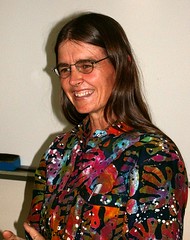The work of ecologist Robin Reid, who spent 15 years conducting pastoral research at the Nairobi headquarters of the International Livestock Research Institute (ILRI) and is now Director for Collaborative Conservation at Colorado State University, in Fort Collins, is featured in a current segment of the American television program ’60 Minutes’, which aired last Sunday, 3 October 2009. You can view the segment on the 60 Minutes website here:
http://www.cbsnews.com/video/watch/?id=5362301n
This story of the great annual wildebeest migration, the last such spectacle of big mammals on the move, focuses on two things—the danger that destruction of Kenya’s Mau Forest presents to the Mara River, the artery that keeps the wildlife and livestock in the Masai Mara region alive, and the hope for sustaining both wildlife populations and the Maasai’s pastoral livelihoods presented by new public-private initiatives called wildlife conservancies.
Poverty reduction lies behind both the danger and the hope.
Kenyan governments have allowed poor farmers to inhabit the Mau Forest, high above the Mara Game Reserve, which provides the waters for the Mara River. These farmers fell the trees to grow crops and make a living. The current government has recently acted to evict these communities to protect this important watershed.
Downstream, meanwhile, Maasai livestock herders, who have provided stewardship for the wildlife populations they live amongst for centuries, are bearing the brunt of the declining water in the Mara River, which threatens both their livestock livelihoods and the populations of big mammals and other wildlife that have made the Mara Game Reserve famous worldwide. Robin Reid says that should the Mara River disappear entirely, some experts estimate some 400,000 animals would likely perish in the very first week.
The new wildlife conservancies being developed in the lands adjacent to the Reserve are also about poverty reduction. They are an ambitious attempt by the local Maasai and private conservation and tourist companies to serve the needs both of the local livestock herders and the many people wanting to conserve resources for the wildlife. The conservancies are paying the Maasai to leave some of their lands open for wildlife. They appear to be working well, with the full support of the local Maasai. Dickson ole Kaelo, who is leading the conservancy effort, was recently a partner in an ILRI research project called Reto-o-Reto, a Maasai term meaning ‘I help you, you help me’. Dickson was a science communicator in that 3-year project, which found ways to help both the human and wildlife populations of this region. In his new role as developer of conservancies, Dickson and his community have managed to bring nearly 300 square miles of Mara rangelands under management by the conservancies, which pay equal attention to people and animals.
The long-term participatory science behind this story is demonstrable proof that, difficult as they are to find and develop, ways to help both people and wildlife, both public and private goods, exist, if all stakeholders come together and if the political will and policy support are forthcoming.
In other, drier, rangelands of Kenya, now experiencing a great drought that is killing half the livestock herds of pastoralists, some experts are predicting an end to pastoral ways of life. Other experts are predicting the end of big game in Kenya. Both, ILRI’s research indicates, are tied to one another. It appears unlikely that either will be saved without the other.

